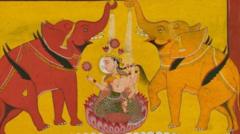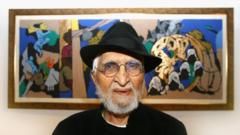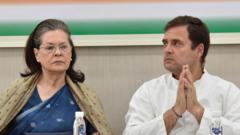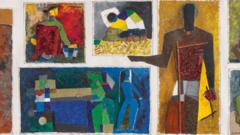A court ruling has reignited discussions on artistic freedom in India.
**Court Orders Seizure of Controversial MF Husain Paintings Amidst Rising Tensions**
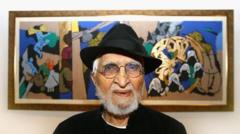
**Court Orders Seizure of Controversial MF Husain Paintings Amidst Rising Tensions**
India's legal battle over art raises questions about freedom of expression and religious sentiments.
In a recent development, a court in Delhi has authorized the police to confiscate two paintings by famed artist MF Husain, arguing that they offend religious sentiments. This decision comes after a lawyer, Amita Sachdeva, filed a complaint pointing to the controversial nature of the works, displayed at the Delhi Art Gallery (DAG) and featuring the Hindu deities Ganesha and Hanuman next to nude figures.
Husain, who passed away in 2011, was no stranger to controversy related to his depictions of religious figures, often facing backlash and even legal repercussions. The current exhibition titled "Husain: The Timeless Modernist" is showcasing over 100 of his artworks from October 26 to December 14, but the focus has shifted due to Sachdeva's complaint. After noticing the offending pieces, she conducted research on prior issues against Husain and promptly filed a police report. During a visit to the gallery with law enforcement, it became apparent that the controversial paintings had been removed, with gallery officials reportedly denying their exhibition.
The police have since claimed to have reviewed CCTV footage of the gallery and submitted findings to the court. The presiding judge noted that the exhibition was a private event dedicated to Husain's original art. Meanwhile, DAG issued a statement declaring it is not a participant in the ongoing legal proceedings and is seeking guidance.
Husain, often referred to as the "Picasso of India," had a prolific career marked by both acclaim and condemnation. His notoriety peaked when he faced severe backlash for depicting nudity in a painting meant to represent India. After receiving threats and facing legal actions, Husain elected to live in exile in London for several years. Despite the controversies, major Indian courts previously upheld Husain’s right to artistic expression, stating that nudity has historical precedence in Indian art and culture.
As the art world braces for further implications of this court decision, the broader conversation concerning the balance between cultural sentiment and artistic freedom continues to prompt deep reflections within Indian society. In a related context, the Bombay High Court recently criticized the customs department for seizing artworks by globally recognized artists on grounds of obscenity, further underscoring the ongoing struggle over the limits of artistic liberty in India.
Husain, who passed away in 2011, was no stranger to controversy related to his depictions of religious figures, often facing backlash and even legal repercussions. The current exhibition titled "Husain: The Timeless Modernist" is showcasing over 100 of his artworks from October 26 to December 14, but the focus has shifted due to Sachdeva's complaint. After noticing the offending pieces, she conducted research on prior issues against Husain and promptly filed a police report. During a visit to the gallery with law enforcement, it became apparent that the controversial paintings had been removed, with gallery officials reportedly denying their exhibition.
The police have since claimed to have reviewed CCTV footage of the gallery and submitted findings to the court. The presiding judge noted that the exhibition was a private event dedicated to Husain's original art. Meanwhile, DAG issued a statement declaring it is not a participant in the ongoing legal proceedings and is seeking guidance.
Husain, often referred to as the "Picasso of India," had a prolific career marked by both acclaim and condemnation. His notoriety peaked when he faced severe backlash for depicting nudity in a painting meant to represent India. After receiving threats and facing legal actions, Husain elected to live in exile in London for several years. Despite the controversies, major Indian courts previously upheld Husain’s right to artistic expression, stating that nudity has historical precedence in Indian art and culture.
As the art world braces for further implications of this court decision, the broader conversation concerning the balance between cultural sentiment and artistic freedom continues to prompt deep reflections within Indian society. In a related context, the Bombay High Court recently criticized the customs department for seizing artworks by globally recognized artists on grounds of obscenity, further underscoring the ongoing struggle over the limits of artistic liberty in India.



